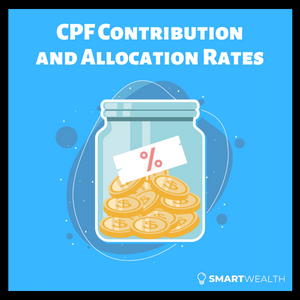Financial planning becomes essential once you enter the workforce.
An integral part of it all is the Central Provident Fund (CPF).
Although CPF draws flak for being “forced savings”, its use is undeniable. For example, part of your CPF savings can be used as a downpayment for your property or to repay your mortgage loan. Without this savings scheme, how many people are able to buy a house when the time comes?
Contributing to your CPF also comes with multiple benefits, especially towards saving for your retirement. This is why understanding and being able to utilise all of what CPF can offer will absolutely improve your financial health.
Today, let’s take things slow and just look at CPF contribution and allocation rates.
So, read on!
Who Needs to Contribute to CPF?
Employees who are Singapore citizens or permanent residents (PRs), working in Singapore, and earning a salary of over $50 per month will have contributions into their CPF accounts.
The total CPF contributions one will receive consist of an employer’s and an employee’s share, both of which are typically a percentage of your salary.
Depending on age, income earned, and residency status, the contribution rates will differ.
Contributions will all be done by your employer, so you don’t have to do anything.
Although the above structure doesn’t apply to self-employed persons (SEPs), they have to make compulsory MediSave contributions if they earn a net trade income (NTI) of above $6,000 a year.
In all, contribution rates can be split into these main categories:
- Singapore citizens and PRs (third year onwards) earning $750/month or more
- Singapore citizens and PRs (third year onwards) earning less than $750/month
- Self-employed persons (SEPs)
For the sake of simplicity, I’ll be leaving out PRs who are in their first and second years.
SIDE NOTE When was the last time you conducted thorough financial planning or reviewed your finances? In this day and age in Singapore, doing so will absolutely improve the quality of life for you and your loved ones. Here are 5 reasons why financial planning is so important.
CPF Contribution Rates for Employees, Employers, and SEPs
Here are the various contribution rates.
Singapore citizens and PRs (third year onwards) earning $750/month or more
Every month, your employer withholds a percentage of your salary and pays that into your CPF accounts. This is the “employee’s CPF contribution”.
In addition, your employer will also need to pay a percentage of your salary into your CPF accounts. This is the “employer’s CPF contribution”.
Here are the contribution rates for employees and employers:
| Age of Employee | By Employer (% of Wage) | By Employee (% of Wage) | Total (% of Wage) |
| 55 & below | 17 | 20 | 37 |
| 56 to 60 | 14 | 14 | 28 |
| 61 to 65 | 10 | 8.5 | 18.5 |
| 66 to 70 | 8 | 6 | 14 |
| Above 70 | 7.5 | 5 | 12.5 |
Note: these rates apply to private sector and public sector non-pensionable employees. They are also subject to limits (I’ll explain more later).
Example:
If you’re 28 years old and earn a salary of $3,500 per month, your contribution would be 20% of your salary, or $700.
You’d then have a remaining $2,800 as take-home salary.
As your employer needs to make an additional contribution of 17% of your salary into your CPF accounts, you’d receive an additional $595.
In total, here’s a breakdown of what you’d receive for a salary of $3,500:
| Take-home salary | $2,800 |
| Employee’s CPF contribution | $700 |
| Employer’s CPF contribution | $595 |
| Total | $4,095 |
Singapore citizens and PRs (third year onwards) earning less than $750/month
Overall, this group of people contributes a lower proportion of their salary into their CPF accounts compared with the group that earns $750/month or more.
The reason for this is that the employee has a greater proportion of take-home pay.
Here are the contribution rates:
(TW = Total Wages)
| Age of Employee | Employee’s Total Wages for the Month | Total CPF Contributions (Employer + Employee) | Employee’s CPF Contributions |
| 55 & below | ≤ $50 | Nil | Nil |
| > $50 to $500 | 17% (TW) | Nil | |
| > $500 to < $750 | 17% (TW) + 0.6 (TW – $500) | 0.6 (TW – $500) | |
| 56 to 60 | ≤ $50 | Nil | Nil |
| > $50 to $500 | 14% (TW) | Nil | |
| > $500 to < $750 | 14% (TW) + 0.42 (TW – $500) | 0.42 (TW – $500) | |
| 61 to 65 | ≤ $50 | Nil | Nil |
| > $50 to $500 | 10% (TW) | Nil | |
| > $500 to < $750 | 10% (TW) + 0.255 (TW – $500) | 0.255 (TW – $500) | |
| 66 to 70 | ≤ $50 | Nil | Nil |
| > $50 to $500 | 8% (TW) | Nil | |
| > $500 to < $750 | 8% (TW) + 0.18 (TW – $500) | 0.18 (TW – $500) | |
| Above 70 | ≤ $50 | Nil | Nil |
| > $50 to $500 | 7.5% (TW) | Nil | |
| > $500 to < $750 | 7.5% (TW) + 0.15 (TW – $500) | 0.15 (TW – $500) |
Self-employed persons (SEPs)
For SEPs, CPF contributions are voluntary.
However, those who earn a net trade income (NTI) of $6,000 or more in a year will have to make compulsory contributions into their CPF MediSave account.
NTI typically means your trade income minus eligible business expenses.
Here are the MediSave contribution rates for SEPs (non-pensioners).
CPF Contribution Limits for Ordinary Wages and Additional Wages
There’s a maximum amount you can contribute into your CPF accounts.
In short, there are three types of caps you should know:
- Ordinary Wage (OW) Ceiling
- Additional Wage (AW) Ceiling
- CPF Annual Limit
DID YOU KNOW? According to a survey conducted by MoneySense, about 3 out of 10 Singapore residents aged 30 to 59 had not started planning for their future financial needs. This isn't surprising because personal finance can seem complicated and daunting. But really, there are only a few things that you should focus on. Learn how to significantly improve your personal finances with the 7-step "wedding cake" strategy today.
1) Ordinary Wage (OW) Ceiling
The OW Ceiling is currently at $6,000.
This means that you’ll only need to make CPF contributions on the first $6,000 of your monthly salary. This also means that employers need not make contributions above that amount.
For example, if you’re a 28-year-old earning a salary of $8,000 a month, your employee CPF contribution would be $1,200 (20% of $6,000), and your employer CPF contribution would be $1,020 (17% of $6,000).
2) Additional Wage (AW) Ceiling
Having said that, you’re likely to earn additional wages, such as annual performance bonuses.
There’s a separate ceiling to classify these additional wages, and here’s the formula:
Yearly AW Ceiling: $102,000 – total OW subject to CPF for that year
So following the previous example of earning a monthly salary of $8,000, your total OW for that year would be $72,000 ($6,000*12), and thus, the AW Ceiling would be $30,000.
What does this mean?
If you’re paid an annual bonus of $20,000, the entire amount would be subject to the CPF contributions. However, if you’re paid a bonus of $50,000 instead, only $30,000 would be subject to CPF contributions.
3) CPF Annual Limit
So far, we’ve talked about CPF contributions made by employees and employers. These are deemed compulsory contributions.
However, you can also make additional voluntary contributions. Doing so not only increases your CPF savings, but you may be able to enjoy further tax reliefs.
There’s a cap on all CPF contributions (mandatory and voluntary) though, and that’s $37,740 per year.
CPF Allocation Rates in 2022: Where Do Your CPF Contributions Go?
In total, there are four types of CPF accounts and they all have different purposes:
| Ordinary Account (OA) | Used for housing, tertiary education, investing, and retirement |
| Special Account (SA) | Can be invested; mainly for retirement |
| MediSave Account (MA) | Used for approved medical expenses and to pay for MediShield Life, Integrated Shield Plan, CareShield, and CareShield Life |
| Retirement Account (RA) | RA is created when you reach 55 years old. Your OA and SA savings will merge and form the RA, which will be your retirement fund |
Your CPF contributions will only go into three accounts, OA, SA, and MA. And how they’re divided will depend on the allocation rates at various ages.
CPF allocation rates for those earning $750/month or more:
| Age | Ordinary Account (ratio of contribution) | Special Account (ratio of contribution) | MediSave Account (ratio of contribution) |
| 35 & below | 0.6217 | 0.1621 | 0.2162 |
| Above 35 – 45 | 0.5677 | 0.1891 | 0.2432 |
| Above 45 – 50 | 0.5136 | 0.2162 | 0.2702 |
| Above 50 – 55 | 0.4055 | 0.3108 | 0.2837 |
| Above 55 – 60 | 0.4286 | 0.1964 | 0.375 |
| Above 60 – 65 | 0.1893 | 0.2432 | 0.5675 |
| Above 65 – 70 | 0.0715 | 0.1785 | 0.75 |
| Above 70 | 0.08 | 0.08 | 0.84 |
Example:
If you’re 28 years old and your wage for a particular month equates to $4,500, here’s your total CPF contribution.
Total CPF contribution: $1,665 ($900 came from your share and $765 came from your employer).
And here’s how your contributions would be distributed.
- Ordinary Account: $1,035.14
- Special Account: $269.89
- MediSave Account: $359.97
*There may be rounding errors.
How CPF Contributions and Allocations Change Throughout Your Lifetime
As you can see, the contribution rates start off higher when you’re young and gradually get lowered when you’re reaching retirement age.
This is because you’re likely to need more savings to own a property. This is also the reason why home ownership is extremely high in Singapore, standing at 87.9% in the year 2020.
At the same time, we’re still contributing to our SAs and MAs for our retirement and healthcare needs.
In the later years, as you would’ve significantly paid off your mortgage loan and there’s a shift towards retirement and the increasing need for healthcare services, a greater proportion of your total CPF contributions go into SA and MA.
What’s Next?
While you’re able to purchase a property with your OA funds, you should remain mindful that your CPF savings (OA and SA balances) are meant for retirement as well.
If you’re using a significant chunk of it towards paying off your mortgage loan, your retirement fund will take an indirect hit.
If so, are you doing anything towards saving for retirement, or at least making sure your excess cash is put into good use?
And have you been employing the best practices of good financial planning?
If you haven’t, consider going through a comprehensive financial planning session today.


